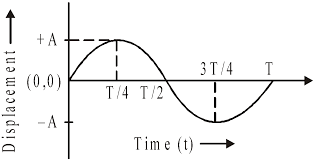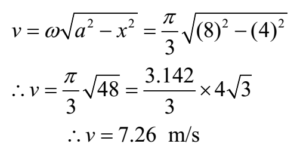Science > Physics > Oscillations: Simple Harmonic Motion > Numerical Problems on Displacement, Velocity, and Acceleration of Particle Performing S.H.M.
in this article, we shall study to calculate the initial phase, displacement, velocity, and acceleration of a body performing S.H.M.

Example – 1:
A particle performs a linear S.H.M along a path 10 cm long. The particle starts from a distance of 1 cm from the mean position towards the positive extremity. Find the epoch and the phase of motion when the displacement is 2.5 cm.
Given: Path length = 10 cm, amplitude = path length /2 = 10/2 = 5 cm, Initial displacement = x0 = 1 cm, Displacement = x = 2.5 cm.
To Find: Epoch = α =? and phase of S.H.M. = (ωt + α) = ?
Solution:
Epoch = α = sin-1(xo/a) = sin-1(1/5) = sin-1(0.2) = 11°32’
Displacement of a particle performing S.H.M. is given by
x = a sin (ωt + α)
∴ 2.5 = 5 sin (ωt + α)
∴ sin (ωt + α) = 2.5/5 = 1/2
∴ (ωt + α) = sin-1(1/2) = π/6
Ans: Initial phase is 11°32’ and phase of S.H.M. is π/6 or 30o.
Example – 2:
The periodic time of a body executing S.H.M. is 2 s. After how much time interval from t =0 will its displacement be half the amplitude?
Given: Time period = T = 2 s, Displacement x = 1/2 a, particle passes through mean position, α = 0.
To Find: Time elapsed = t =?
Solution:
Angular velocity = ω = 2π/T = 2π/2 = π rad/s
Displacement of a particle performing S.H.M. is given by
x = a sin (ωt + α)
∴ 1/2 a = a sin (πt + 0)
∴ 1/2 =sin (πt)
∴ πt = sin-1(1/2) = π/6
∴ t = 1/6 s
Ans: After 1/6 s the displacement will be half the amplitude
Example – 3:
A particle executes S.H.M. of amplitude 25 cm and time period 1/3 seconds. What is the minimum time required for a particle to move between two points located at a distance of 12.5 cm on either side of the mean position?
Given: amplitude = a = 25 cm, x = 12.5 on either side, Period = T = 3 s, particle passes through mean position, α = 0.
To Find: Time required = 2t = ?
Solution:
Angular velocity = ω = 2π/T = 2π/3 rad/s
Displacement of a particle performing S.H.M. is given by
x = a sin (ωt + α)
∴ 12.5 = 25 sin ((2π/3)t + 0)
∴ 1/2 =sin ((2π/3)t)
∴ (2π/3)t = sin-1(1/2) = π/6
∴ t = 1/4 s
Now the points are on either side of the mean position
Hence time taken to move between these two points = 2t = 2 x 1/4 = 0.5 s
Ans: the minimum time required is 0.5 s
Example – 4:
A particle executes S.H.M. of period 12 s and of amplitude 8 cm. What time will it take to travel 4 cm from the extreme position ?
Given: Period = T = 12 s, amplitude = a = 8cm, distance from extreme position = 4 cm, displacement = x = 8 cm – 4 cm = 4 cm, particle starts from extreme position, α = π/2.
To Find: time taken = t = ?, Velocity = v = ?
Solution:
Angular velocity = ω = 2π/T = 2π/12 = π/6 rad/s
Displacement of a particle performing S.H.M. is given by
x = a sin (ωt + α)
∴ 4 = 8 sin ((π/6)t + π/2)
∴ 1/2 =cos ((π/6)t)
∴ (π/6)t = cos-1(1/2) = π/3
∴ t = 2 s
Ans: Time taken = 2 s
Example – 5
A particle performs S.H.M. of period 4 s. If the amplitude of its oscillations is 4 cm, find the time it takes to describe 1 cm from the extreme position.
Given: Period = T = 4 s, amplitude = a = 4cm, distance from extreme position = 1 cm, displacement = x = 4 cm – 1 cm = 3 cm, particle starts from extreme position, α = π/2.
To Find: time taken = t = ?
Solution:
Angular velocity = ω = 2π/T = 2π/4 = π/2 rad/s
Displacement of a particle performing S.H.M. is given by
x = a sin (ωt + α)
∴ 3 = 4 sin ((π/2)t + π/2)
∴ 3/4 = cos ((π/2)t)
∴ (π/2)t = cos-1(3/4) = 41.41° = 41.41 x 0.0175= 0.7247 rad
∴ t = 0.7247 x 2 /3.142 = 0.4613 s
Ans: Time taken = 0.4613 s
Example – 6
A particle performs S.H.M. of period 12 s along a path 16 cm long. If it is initially at the positive extremity, how much time will it take to cover a distance of 6 cm from that position?
Given: Period = T = 12 s, path length = 16 cm, amplitude = a = 16/2 = 8cm, distance from extreme position = 6 cm, displacement = x = 8 cm – 6 cm =2 cm, particle starts from extreme position, α = π/2.
To Find: time taken w.r.t. extreme position = te = ?
Solution:
Angular velocity = ω = 2π/T = 2π/12 = π/6 rad/s
Displacement of a particle performing S.H.M. is given by
x = a sin (ωt + α)
∴ 2 = 8 sin ((π/6)t + π/2)
∴ 2/8 = cos ((π/6)t)
∴ (π/6)t = cos-1(1/4) = 75.52° =75.52 x 0.0175 = 1.322 rad
∴ t = 1.322 x 6 /3.142 = 2.52 s
Ans: Time taken =2.52 s
Example – 7:
The shortest distance traveled by a particle performing S.H.M. from its mean position in 2 seconds is equal to √3/2 of its amplitude. Find its period.
Given: Time elapsed = t = 2s, displacement = x = a √3/2, particle passes through mean position, α = 0.
To Find: Period = T = ?
Solution:
Displacement of a particle performing S.H.M. is given by
x = a sin (ωt + α)
∴ a √3/2 = a sin (ωt + 0)
∴ √3/2 = sin ωt
∴ ωt = sin-1(√3/2 ) = π/3
∴ (2π/T)t = π/3
∴ (2π/T)x 2 = π/3
∴ T = 2 x 2 x 3 = 12 s
Ans: Period is 12 s
Example – 8:
A particle performing S.H.M. has a period of 6 s and amplitude of 8 cm. The particle starts from the mean position and moves towards the positive extremity. Find its displacement, velocity, and acceleration 0.5 s after the start.
Given: Period = T = 6 s, amplitude = a = 8cm, time elapsed = t = 0.5 s, particle starts from mean position, α = 0.
To Find: Displacement = x = ?, Velocity = v =?, acceleration = f = ?
Solution:
Angular velocity = ω = 2π/T = 2π/6 = π/3 rad/s
Displacement of a particle performing S.H.M. is given by
x = a sin (ωt + α)
∴ x = 8 sin ( π/3 x 0.5 + 0)
∴ x = 8 sin ( π/6) = 8 x 1/2 = 4 cm
The magnitude of the velocity of a particle performing S.H.M. is given by

The magnitude of the acceleration of a particle performing S.H.M. is given by
f = ω2x = (π/3)2 x 4 = (3.142/3)2 x 4 = 4.38 cm/s2.
Ans: Displacement = 4 cm; velocity = 7.26 cm/; acceleration = 4.38 cm/s2
Example – 9:
A sewing machine needle moves in a path 4 cm long and the frequency of its oscillations is 10 Hz. What are its displacement and acceleration 1/120 s after crossing the centre of its path?
Given: Path length = 4 cm, amplitude = path length/2 = 4/2 = 2 cm, Frequency of oscillation = n = 10 Hz, Time elapsed = t = 1/120 s, particle passes through mean position, α = 0.
To Find: Displacement = x =? acceleration = f =?
Solution:
Agular velocity = ω = 2πn = 2π x 10 = 20π rad/s
Displacement of a particle performing S.H.M. is given by
x = a sin (ωt + α)
∴ x = 2 sin ( 20π x 1/120 + 0)
∴ x = 2 sin ( π/6) = 2 x 1/2 = 1 cm
The magnitude of the acceleration of a particle performing S.H.M. is given by
f = ω2x = (20π)2 x 1 = (20 x 3.142)2 = 3944 cm/s2.
Ans: Displacement =1 cm and acceleration = 3944 cm/s2
Previous Topic: Theory of Simple Harmonic Motion
Next Topic: Numerical Problems on Maximum Velocity and Maximum Acceleration of S.H.M.
2 replies on “Numerical Problems on S.H.M.- 01”
It’s a good and good defines itself very helping
I can get what I search for